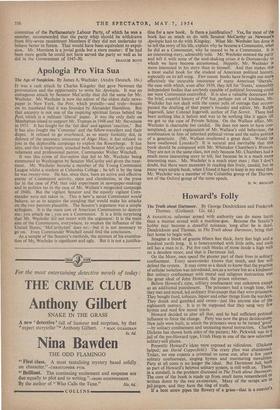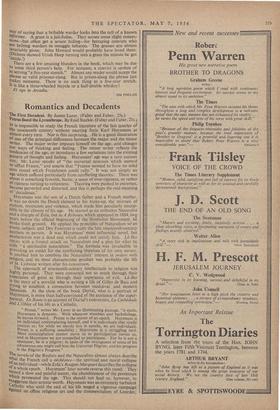Howard's Folly
The Truth about Dartmoor. By George Dendrickson and Frederick Thomas. (Gollancz. 12s. 6d.) A FANATICAL reformer armed with authority can do more harm than a maniac armed with a machine-gun. Because the fanatic's hobby may become a dreadful nuisance, long after he is dead. Dendrickson and Thomas, in The Truth about Dartmoor, bring that fact home to begin with. Imagine a block of granite fifteen feet thick, forty feet high and a hundred yards long. It is honeycombed with little cells, and each cell has a man in it. Put five such blocks of stone inside a high wall on a desolate moor, and that is Dartmoor Jail. On the Moor, men spend the greater part of their lives in solitary confinement. Every news-reader knows that much, and few will defend the system. It may come as a shock to know that the practice of cellular isolation was introduced, not.as a torture but as a kindness! But solitary confinement with moral and religious instruction was the great ideal of John Howard, the prison reformer. Before Howard's time, solitary confinement was unknown except as an additional punishment. The prisoners had a tough time, but they met and mixed, led ordinary lives except that they were prisoners. They bought food, tobacco, liquor and other things from the warders. They drank and gambled and swore—just like anyone else of the eighteenth century. It is to be supposed that they sang very few hymns and read few moral tracts. Howard decided to alter all that, and he had sufficient political influence to force the change. Piety was now the great desideratum. New jails were built, in which the prisoners were to be turned 'good' —by solitary confinement and unceasing moral instruction. Charles Dickens has shown both sides of the picture; Mr. Pickwick was in a jail of the pre-Howard type, Uriah Heep in one of the new reformed solitary-cell places. Presently Howard's ideas were exposed as ridiculous. (Dickens helped; see David Copperfield.) The crazy plan was abandoned. Today, no one expects a criminal to come out, after a few years solitary confinement, singing hymns and murmuring moralities. Piety at all costs is no longer the ideal. But Dartmoor Jail, built as part of Howard's beloved solitary system, is still with us. There, in a nutshell, is the problem discussed in The Truth about Dartmoor. The core of the book is made up from small items remembered or written down by the two ex-convicts. Many of the scraps are in jail-jargon, and they have the ring of truth.
Way of saying that a bribable warder looks into the cell of a known Informer. A grass is a jail-Judas. They secure some slight conces- sions—but often get a severe hiding—for betraying convicts whO are bribing warders to smuggle tobacco. The grasses are almost Invariably pious. John Howard would probably have loved them. (Dickens showed Uriah Heep turning into a grass the minute he got 'inside?) There are a few amusing blunders in the book, which may be due to some third person's help. For instance, a convict is spoken of as serving "a five-year stretch." Almost any reader would accept the just makes as valid prisoner-slang. But in prison-slang the phrase ust Makes nonsense. There is no such thing as a live-year stretch. It is like a three-wheeled bicycle or a half-double whiskey!
Et ego in Arcadia. JIM PHELAN











































 Previous page
Previous page